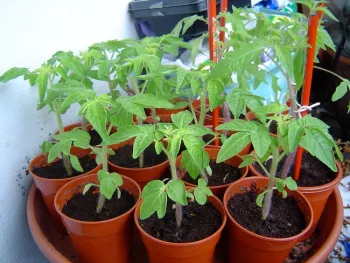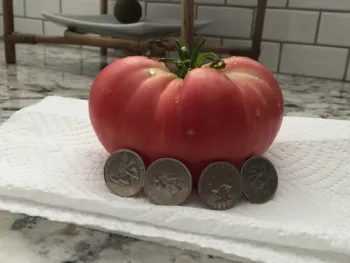Ode to a Tomato

The tomato, commonly called a vegetable, is a fruit botanically, and hard to believe but the tomato was the center of a U.S. Supreme Court decision, Nix vs. Hedden. Now, this is a fascinating bit of historical trivia. In the 1800's there was a tariff that put a tax on imported vegetables. Well, a business owner in New York City named John Nix wasn't too happy about this. He sued Edward Hedden, the “Collector of the Port of NYC” (tax collector). Mr. Nix declared that since tomatoes are a fruit, he was owed back taxes.

In Stanislaus County from early July and for months afterward, you'll see tomato truck gondolas on the road 24 hours a day filled with red, ripe tomatoes rushing to processors. We have perfect tomato growing conditions.
A tomato is not too picky. That's another reason it's so popular to grow. All that is required is full sun, an area (container or ground) with some soil, a support of some type, some water, some fertilizer, and a little love.
If you are a container/patio gardener, look on the label or tag for the term “determinate,” as these plants work best in containers. Also, anything named patio or pixie. Cherry tomato varieties are indeterminate but work great in a container. Use at least a 5-gallon bucket-sized container (with holes in the bottom). Your plant will need some support, but not as much as the indeterminate varieties.

To ensure your plant is planted correctly, make your hole as wide and deep as the root ball of the plant. This is the area of soil and roots that you remove from the original container. The cool thing about tomatoes is you can plant them as deep as you need to if they are leggy.
To plant, carefully remove the root ball, and gently loosen the root mass and with gardening clippers or scissors remove lower branches. You are going to plant about 1/3 of the green plant below the soil. Gently pat the soil around the plant . Don't forget to place your support around or next to the plant now so you don't forget. Water gently and stand back and admire your gardening expertise. And imagine those delicious tomatoes gracing your salad, sandwich, or as I like to do, eat them out of my hand with a few napkins to catch the juice.

I hope you plant at least one tomato plant this season and send us pictures of your successes to ucmgstanislaus@ucanr.edu. Happy gardening and enjoy those dirty hands.
Be sure to join Rho on Wednesday, April 15 at 6 p.m. for Spring Container Vegetable Gardening. Sign up on our class website at https://ucanr.edu/sites/stancountymg/Classes/
